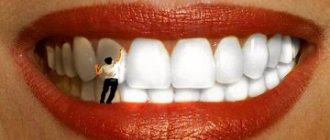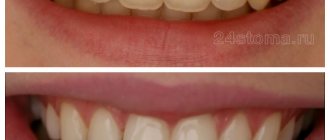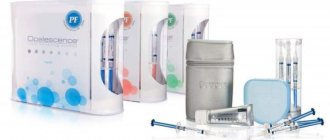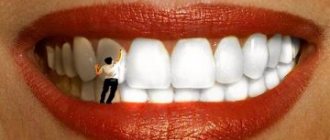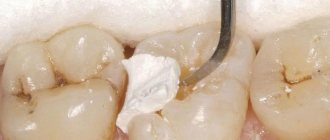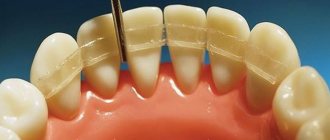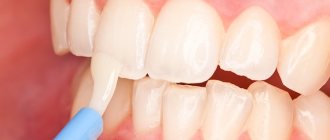Temporary dental crowns are crowns made from inexpensive materials that are used during prosthetics only to protect teeth until permanent crowns are installed.
The purpose of using temporary crowns is to strengthen teeth and give them a natural appearance.
Such crowns are not very stable and have limited aesthetics. They are installed on a previously ground tooth or on an implant.
Why do we need temporary crowns on teeth - what they are and how long they are worn
Article navigation
- What are temporary crowns?
- Functions and purpose
- Types of temporary crowns
- How long does the service life last?
- Advantages and disadvantages
- Manufacturing methods and installation
- Is it safe to use temporary prosthetics?
- How to remove a prosthesis
- Rules for wearing, care and adaptation
- Cost of products
Question for a specialist
Gold crowns are familiar to every person - they are a classic of prosthetics that are already becoming a thing of the past. Now there are more modern materials - metal ceramics, ceramics, zirconium dioxide and ceramic composite. And all of them are used for permanent dentures that are worn for years. But there are also temporary dental crowns that need to be worn for a shorter period of time. In today's material we will talk about all the features of temporary crowns - their types, why they are needed, how they are made and placed, how long they are worn, as well as the cost.
Materials for temporary structures
Most often, temporary structures are made of plastic. But some clinics use modern composite materials and acrylic plastics to produce pharmaceutical products. The cost of temporary crowns depends on the type of material, which differ in the following indicators:
- - production time
- — rate of hardening of the material
- — ease of shape modeling
- - possibility of correction
- - degree of strength
- - life time
Why are such prostheses needed - functions and purpose?
What are temporary crowns needed for, and why are they placed? The manufacture of any permanent dentures requires a certain amount of time – usually three or more days. At the same time, the supporting teeth have already passed the processing stage and do not look quite aesthetically pleasing - after all, they are quite sharply ground. Therefore, if the question arises - why are temporary crowns placed before permanent ones, you need to understand that they serve the following purposes:
- protection of the ground tooth and surrounding gums from mechanical damage: during chewing food or brushing with a toothbrush. Inflammation of the gums or dental “nerve” should not be allowed. It is also necessary to maintain the shape of the support, because the permanent “cap” is made using casts from the support – and if it breaks, you will have to start prosthetics “from scratch”
- protection from external irritants: acids, temperature changes,
- restoration of dental aesthetics,
- restoration of the functionality of the tooth: of course, in this case its “functionality” will be incomplete, because strong chewing pressure can damage the root or implant,
- acceleration of adaptation to a permanent prosthesis,
- normalization and correction of the position of the gums, if such a crown is placed on a newly installed implant.
South Korean implant Osstem - from 35,000 rubles.
Hurry up to sign up for a free consultation and lock in promotional prices.
Call now or request a call
Opening hours: 24 hours a day - seven days a week
There are quite a few methods for restoring the beauty of a smile reliably and efficiently. However, almost all of them involve the manufacture of prostheses, which sometimes takes several days.
Installing a ceramic or metal-ceramic crown is a multi-step process that can take from several days to several weeks. What to do with the tooth prepared for permanent construction during this period? While the prosthesis is being made, it can be replaced by a temporary tooth. But often in the process of communicating with patients, we hear questions about the advisability of making temporary crowns, especially when an orthopedic dentist suggests placing a temporary crown for a short time before making a permanent structure.
Patients often wonder why temporary crowns are needed when they can just walk around with their teeth ground for a while. After all, such prostheses are installed only for the duration of orthopedic treatment, but require separate manufacturing.
Until recently, temporary crowns were not considered a necessity. However, over time, it became clear that their use significantly improves the quality of treatment and reduces the likelihood of complications after prosthetics.
The importance of using temporary structures has been proven by numerous studies. A high-quality temporary crown, made of materials with low thermal conductivity, protects the tooth pulp from external irritating factors. The main condition is that the crown must fit tightly to the boundaries of the tooth tissue to prevent saliva from getting under it.
In a healthy, intact tooth, the protective function lies on the enamel. However, in the process of preparing for prosthetics, this tissue is almost completely “cut down”. A tooth treated for a crown is exposed and vulnerable to various irritants (temperature, chemical). Therefore, in a ground tooth, a temporary crown takes on a protective role.
The temporary structure also has an occlusal function. It helps to chew normally and protects gum tissue from mechanical damage from food. In addition, a temporary crown ensures proper contact between teeth, preventing unwanted movements.
Many experts believe that the use of temporary crowns even prevents the development of pathologies of the joints and muscles of the maxillofacial area. It is also important that temporary structures maintain aesthetics during orthopedic treatment. This is especially true for the front teeth.
Usually, before installing a crown or prosthesis, the tooth needs to be ground, and only after grinding can impressions be taken and the manufacture of dentures begin. A ground tooth looks very unsightly and causes both aesthetic and psychological discomfort to the patient.
To restore the aesthetics and functionality of the dentition, temporary, or provisional, crowns are used.
They are especially relevant for the front teeth. However, plastic crowns not only mask visual defects in the dentition.
Functions of temporary crowns
• Temporarily restore the function of the ground tooth;
• Allows you to maintain normal diction;
• Do not allow infection to enter the tissues of the prepared tooth;
• Prevent gum tissue from growing onto the tooth to ensure normal installation of a permanent crown;
• Allow a person to quickly get used to a permanent crown;
• Firmly fix the tooth and prevent it from moving to the sides or staggering;
• Maintains bite, preventing neighboring teeth from taking up free space;
• If a tooth is ground down without removing the nerve, it becomes very sensitive to temperature and chemical stimuli, which can cause pain. A temporary crown protects such a tooth.
What are temporary crowns made of?
Temporary structures are made by a dental technician from monomer plastic in the laboratory or from monomer-free (hypoallergenic) composite plastic by an orthopedic dentist in a clinic. Special fast-hardening plastic is characterized by an external resemblance to the color and texture of natural teeth, because it, like ceramics or filling material, is selected according to color and shape. The temporary structure in the oral cavity looks so natural that many people around you may not notice that you are currently at the stage of prosthetics from an orthopedic dentist. Plastic also has high strength values, which makes it possible to make crowns from it for both front and side teeth. Before metal-ceramic crowns became widespread in dental practice, doctors widely used prosthetics using plastic.
For a temporary structure, fast-hardening dental resin is an ideal material - durable, aesthetic and cheap.
Disadvantages of temporary crowns
Temporary crowns are made very quickly and are quite convenient, but they have a number of disadvantages.
It is because of these shortcomings that they cannot be used as permanent prostheses:
• The material of the temporary crown is porous, which makes it easy for infection to penetrate. If the patient neglects the rules of hygiene, the pathogenic microflora will easily reach the ground tooth, which will lead to the development of an inflammatory process. In addition, even with careful hygiene, harmful substances gradually accumulate in the temporary crown;
• Temporary crowns change color very easily when exposed to certain drinks or foods, such as wine, coffee, strong tea, berries, etc. However, it will not be possible to whiten the temporary crown;
• A temporary crown is not strong enough, it has a very short service life and will simply break over time.
Service life of temporary crowns.
With temporary crowns, a person can walk for quite a long time (from several days to 4-5 months), but not constantly. It is worth remembering that any plastic is a very hygroscopic material that absorbs moisture and pigments well, as a result of which it swells and changes color. Plastic crowns are not intended for constant wear: as practice has shown, this does not lead to anything good. Teeth permanently covered with plastic crowns are destroyed and must soon be removed.
How to care for temporary crowns?
You must remember to follow some rules for caring for temporary structures in the oral cavity. This will help avoid its de-cementing (the appearance of mobility):
- Distribute the load on the teeth so that it is minimal on the side of the temporary crown.
- Avoid eating sticky or hard foods to avoid dislodging or damaging the temporary crown.
- Brush your teeth gently and thoroughly with a medium-hard toothbrush.
- When using dental floss to clean between teeth, do not pull it out, holding both ends with your fingers and pulling the thread down. It’s better to let go of one of its ends and slowly pull the end remaining in your hand away from your face.
- Do not wear the crown for more than the period recommended by your doctor!
Thus, the use of temporary crowns is a necessary intermediate step for the patient himself in any type of prosthetics.
Types of temporary crowns
The classification of temporary crowns can be based on the material (from which they are made) and the support (on which they will be fixed). Let's consider this classification in more detail.
By material
What are temporary crowns made of? They are created from the cheapest materials - they are usually plastic or acrylic. Temporary dentures can be made of plastic on a frame made of metal mesh or fiberglass. A composite resin material similar to a filling compound can also be used. Composite caps have better characteristics - they are more durable and look more natural.
All materials are very easy to adjust and process, so that in most situations the patient will be able to leave the doctor’s office with a beautiful smile.
What support will they be installed on?
Previously, temporary crowns were placed only on natural teeth - not only on the ground stump, but also on the stump inlay. With the development of technology and the introduction of implantation, these provisional “caps” began to be placed on implants (or rather, on their supragingival parts - abutments).
What else do you need to know about “temporary solutions”?
Perhaps many people believe that doctors, when drawing up treatment plans, are guided by their own experience and treat “as they see fit.” This is not entirely true.
The treatment methods used by doctors are based on clinical recommendations and protocols that are developed by international and Russian professional medical associations.
Regarding “temporary” crowns, the Russian Dental Association recommends the use of temporary dentures as a cosmetic and functional guideline for the manufacture of permanent denture structures.
Therefore, if a doctor suggests using a temporary one before installing a permanent crown, this is not a desire to delay treatment and earn more money, but to follow personal clinical experience and the recommendations of authoritative colleagues. And all this in order to guarantee the patient a successful treatment result as much as possible.
How long does the service life last?
How long can you wear temporary crowns? Most patients go with them for a fairly short period of time - about 2 weeks. If more time is required to manufacture the prosthesis, the service life can be increased to 1 month. Dentists do not recommend wearing plastic “caps” for longer, because... they quickly become unusable, and as a result, the supporting tooth “suffers.” But composite ones can be worn for a longer period - up to several months, but not more than 1 year. Temporary dentures on implants are usually worn until the implant itself has taken root - up to 6 months. Here they have a slightly different fixation system, which is why the wearing period increases.
“I wanted to whiten my teeth before my wedding, but I went too far with the exposure time of the whitening strips and ended up with serious problems. The dentist said that I need to get crowns because with my fillings it is useless to build them up. And “Day X” is getting closer... I had to install temporary composite ones for now, they said that I could do this for 3-4 months. And the doctor chose the color very well, the smile in the photos is simply gorgeous!”
Anastasia, review from forum.stom.ru
Advantages and disadvantages
The advantages of temporary crowns include the following:
- plasticity of the material: the “cap” can be easily modified directly in the patient’s mouth. It won't cause any discomfort.
- lightness of the design and speed of its manufacture: in just 1 hour you can “hide” a ground tooth or implant under a temporary prosthesis, which will not put strong pressure on the support and gums,
- low cost: many clinics include this price in the general price list,
- quite good aesthetics: of course, this directly depends on the material. Therefore, it is better to choose products made from composite, they look more natural and last longer,
- high-quality tooth protection from light loads,
- there is no need for special hygienic care,
- Possibility of installation with bracket systems and aligners.
Such prostheses also have disadvantages, and it is because of them that the wearing period is often reduced:
- plastic quickly darkens: under the influence of tea, coffee, etc. It is impossible to bleach it, because... the pigment penetrates deeply into the porous structure of the plastic. Therefore, plastic dentures quickly darken even with high-quality care,
- the original color of the plastic is very white: this is also a minus, since the “cap” makes other segments of the smile look unattractive,
- allergic reactions are possible: this applies to a greater extent to plastic and acrylic,
- the fixation on the support is not very tight (like permanent ones): which can lead to peeling off,
- You must adhere very strictly to dietary recommendations: you cannot eat hard foods, or very hot or cold foods. Dentists advise avoiding dark and brightly colored foods.
- short operating time.
Manufacturing methods and installation of the product
How are temporary crowns made and how are they attached? Manufacturing is possible in two ways - direct and indirect. What it is and what technology each method has, we will explain further.
Direct method
You can also call it “office”. The direct method involves making a prosthesis directly at an appointment with an orthopedist (“prosthetist”). Moreover, all the work is done by the dentist himself, because... The method is quite simple, and there is no need to involve the power of a dental laboratory. Manufacturing by the direct method looks like this:
- grinding of a natural tooth or installation of a core inlay,
- taking impressions of the dentition after grinding for a permanent prosthesis,
- production of a temporary prosthesis from a composite directly on the tooth,
- The product holds quite tightly throughout the stated wearing period, without shifting.
There are also template models made of plastic - they are simply adjusted to a specific patient right in the dentist’s office. They are fixed with special adhesive cement. Manufacturing time using the direct method is usually no more than 1-2 hours.
Indirect method
The indirect method already involves the involvement of equipment and dental laboratory specialists. Manufacturing no longer takes 1-2 hours, but 1-2 days, and it occurs after the orthopedist transfers the impressions to the dental technicians. Based on the casts, a plaster model is modeled, which is necessary for casting and fitting the product. This approach makes it possible to achieve higher accuracy and a tight fit on the support due to strict adherence to the anatomical features of the dentition.
Making a dental crown in a dental laboratory.
After completing the medical stages, a fighter on the invisible front for the patient—the dental technician—comes into action. The resulting impressions are sent to the dental laboratory, where the actual production of the crown itself takes place. Schematically it looks like this:
— an impression technician casts a plaster model
— the frame of the future crown is modeled from wax on the treated tooth
— the wax frame is melted into metal (in the case of making a metal-ceramic crown) or transferred to a zirconium dioxide/lithium disilicate frame to make a metal-free crown (more on this in part two)
— then the technician applies layer-by-layer ceramic mass to the frame, which initially looks like thick sour cream, and after baking in a special oven takes on a “human” appearance. At the same time, the technician tries to the best of his ability to give the crown the desired anatomical shape and the desired color.
How to remove a prosthesis
How are temporary crowns removed? It is worth noting that removal should only be carried out by a doctor. This procedure is painless and does not require any special preparation from the patient. But it should not be carried out by him himself. Let's look at the removal process step by step:
- the prosthesis is exposed to ultrasonic waves, from which the adhesive base begins to crumble,
- removal using a special tool (crown remover or Kopp apparatus): it has a small hook and lever,
- cement residues are removed from the support using ultrasound,
- diagnostics of the abutment tooth is carried out: for damage and inflammatory processes,
- a temporary or permanent prosthesis is installed: the choice depends on the stage of prosthetics.
Complex on 4 OSSTEM implants with delayed loading - from RUB 170,000.
Complex implantation Osstem (South Korea) with delayed loading after 4-6 months.
Guarantee for the doctor’s work - unlimited Call now or order a call
Opening hours: 24 hours a day - seven days a week
What to do if the crown falls out on its own? To avoid complications, you should put it in a clean container and contact your dentist. You cannot reinstall it yourself, otherwise you may damage the support or cause inflammation. Moreover, you should not use any adhesives not intended for the oral cavity, as well as chewing gum.
Rules for wearing, care and adaptation
Temporary prosthetics are created very quickly and are not highly accurate, and naturally, the patient may feel some discomfort after its installation. Most often, such a prosthesis will interfere a little when closing the jaws. It is recommended that you tell your doctor about all the inconveniences, who will make adjustments and make it more comfortable and convenient.
Since temporary cement is used for fixation, the provisional prosthesis is not very securely fixed in the oral cavity. Therefore, to protect it (and the tooth itself), some precautions should be taken:
- avoid eating “stretchy” foods: toffees, chewing gum, etc.,
- reduce the chewing load on the temporary prosthesis: it is better to chew food on the opposite side,
- avoid eating solid foods
- Carry out hygiene procedures with caution: use threads especially carefully. An irrigator that gently and efficiently removes pieces of food from the interdental spaces will be a good help.
